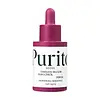What's inside
What's inside
 Key Ingredients
Key Ingredients

 Benefits
Benefits

 Concerns
Concerns

No concerns
 Ingredients Side-by-side
Ingredients Side-by-side

Water
Skin ConditioningButylene Glycol
HumectantGlycerin
HumectantPentaerythrityl Tetraethylhexanoate
EmollientBetaine
HumectantBakuchiol
AntimicrobialHydrangea Macrophylla Leaf Extract
Skin ConditioningAcetyl Hexapeptide-8
HumectantLavandula Angustifolia Extract
Skin ConditioningRosmarinus Officinalis Extract
AntimicrobialOriganum Vulgare Flower/Leaf/Stem Extract
Skin ConditioningThymus Vulgaris Extract
PerfumingAllantoin
Skin ConditioningAdenosine
Skin ConditioningCetearyl Olivate
Hydroxyacetophenone
AntioxidantSorbitan Olivate
EmulsifyingCetearyl Alcohol
EmollientCetyl Palmitate
EmollientSodium Acrylate/Sodium Acryloyldimethyl Taurate Copolymer
Emulsion StabilisingPolyisobutene
Sorbitan Palmitate
EmulsifyingDipotassium Glycyrrhizate
HumectantDisodium EDTA
Sorbitan Oleate
EmulsifyingEthylhexylglycerin
Skin ConditioningCarbomer
Emulsion StabilisingXanthan Gum
EmulsifyingArginine
MaskingCaprylyl/Capryl Glucoside
Cleansing1,2-Hexanediol
Skin ConditioningWater, Butylene Glycol, Glycerin, Pentaerythrityl Tetraethylhexanoate, Betaine, Bakuchiol, Hydrangea Macrophylla Leaf Extract, Acetyl Hexapeptide-8, Lavandula Angustifolia Extract, Rosmarinus Officinalis Extract, Origanum Vulgare Flower/Leaf/Stem Extract, Thymus Vulgaris Extract, Allantoin, Adenosine, Cetearyl Olivate, Hydroxyacetophenone, Sorbitan Olivate, Cetearyl Alcohol, Cetyl Palmitate, Sodium Acrylate/Sodium Acryloyldimethyl Taurate Copolymer, Polyisobutene, Sorbitan Palmitate, Dipotassium Glycyrrhizate, Disodium EDTA, Sorbitan Oleate, Ethylhexylglycerin, Carbomer, Xanthan Gum, Arginine, Caprylyl/Capryl Glucoside, 1,2-Hexanediol
Water
Skin ConditioningGlycerin
HumectantButylene Glycol
HumectantCaprylic/Capric Triglyceride
MaskingUndecane
EmollientBakuchiol
AntimicrobialAloe Barbadensis Leaf Extract
EmollientWithania Somnifera Root Extract
Skin ConditioningVaccinium Corymbosum Fruit Extract
Skin ConditioningTasmannia Lanceolata Leaf Extract
Skin ConditioningFucus Vesiculosus Extract
EmollientPropanediol
Solvent1,2-Hexanediol
Skin ConditioningCetearyl Olivate
Tridecane
PerfumingHydroxyacetophenone
AntioxidantSorbitan Olivate
EmulsifyingPolyacrylate Crosspolymer-6
Emulsion StabilisingSodium Benzoate
MaskingPentylene Glycol
Skin ConditioningTocopherol
AntioxidantCaprylyl Glycol
EmollientPotassium Sorbate
PreservativeWater, Glycerin, Butylene Glycol, Caprylic/Capric Triglyceride, Undecane, Bakuchiol, Aloe Barbadensis Leaf Extract, Withania Somnifera Root Extract, Vaccinium Corymbosum Fruit Extract, Tasmannia Lanceolata Leaf Extract, Fucus Vesiculosus Extract, Propanediol, 1,2-Hexanediol, Cetearyl Olivate, Tridecane, Hydroxyacetophenone, Sorbitan Olivate, Polyacrylate Crosspolymer-6, Sodium Benzoate, Pentylene Glycol, Tocopherol, Caprylyl Glycol, Potassium Sorbate
 Reviews
Reviews

Ingredients Explained
These ingredients are found in both products.
Ingredients higher up in an ingredient list are typically present in a larger amount.
1,2-Hexanediol is a synthetic liquid and another multi-functional powerhouse.
It is a:
- Humectant, drawing moisture into the skin
- Emollient, helping to soften skin
- Solvent, dispersing and stabilizing formulas
- Preservative booster, enhancing the antimicrobial activity of other preservatives
Bakuchiol is a plant-derived antioxidant (it's vegan!). It is often called the replacement for retinol although it is not part of the same family.
It has similar effects as retinol: skin smoothing, reducing discoloration, and preventing wrinkles. It does not cause as much irritation as traditional retinoids.
Bakuchiol works by breaking down free radicals and stimulating collagen production in skin.
Combining bakuchiol with retinol will not have adverse side effects. Studies show using them will just boost the benefits. Bakuchiol is also found to help stabilize retinol.
While bakuchiol does not make the skin more sun sensitive, we recommend wearing SPF on a daily basis.
Read more about traditional retinol
Learn more about BakuchiolButylene Glycol (or BG) is used within cosmetic products for a few different reasons:
Overall, Butylene Glycol is a safe and well-rounded ingredient that works well with other ingredients.
Though this ingredient works well with most skin types, some people with sensitive skin may experience a reaction such as allergic rashes, closed comedones, or itchiness.
Learn more about Butylene GlycolCetearyl Olivate is an emulsifier and texture enhancer. It is derived from the fatty acids of olive oil and Cetearyl alcohol, and is biodegradable.
As an emulsifier, it is used to prevent oils and waters from separating. It can also
Manufacturers use the name Olivem 1000. This ingredient has been found to preserve the natural microbiome of skin. Having a healthy microbiome helps keep our skin healthy and protects against harmful bacteria. This ingredient is grouped with Sorbitan Olivate under the name Olivem 1000.
Learn more about Cetearyl OlivateGlycerin is already naturally found in your skin. It helps moisturize and protect your skin.
A study from 2016 found glycerin to be more effective as a humectant than AHAs and hyaluronic acid.
As a humectant, it helps the skin stay hydrated by pulling moisture to your skin. The low molecular weight of glycerin allows it to pull moisture into the deeper layers of your skin.
Hydrated skin improves your skin barrier; Your skin barrier helps protect against irritants and bacteria.
Glycerin has also been found to have antimicrobial and antiviral properties. Due to these properties, glycerin is often used in wound and burn treatments.
In cosmetics, glycerin is usually derived from plants such as soybean or palm. However, it can also be sourced from animals, such as tallow or animal fat.
This ingredient is organic, colorless, odorless, and non-toxic.
Glycerin is the name for this ingredient in American English. British English uses Glycerol/Glycerine.
Learn more about GlycerinHydroxyacetophenone is antioxidant with skin conditioning and soothing properties. It also boosts the efficiency of preservatives.
This ingredient is not irritating or sensitizing.
Sorbitan Olivate is created from the fatty acids in olive oil and sorbitol.
This ingredient is an oil in water emulsifier. It helps stabilize a product by preventing oils and waters from separating. Sorbitan Olivate also helps hydrate the skin.
Manufacturers sell sorbitan olivate under the name OliveM 1000. OliveM 1000 a multifunctional ingredient. It is self-emulsifying. According to a manufacturer, OliveM 1000 does not disrupt natural skin biome.
Due to its olive oil base, this ingredient may not be fungal-acne safe.
Learn more about Sorbitan OlivateWater. It's the most common cosmetic ingredient of all. You'll usually see it at the top of ingredient lists, meaning that it makes up the largest part of the product.
So why is it so popular? Water most often acts as a solvent - this means that it helps dissolve other ingredients into the formulation.
You'll also recognize water as that liquid we all need to stay alive. If you see this, drink a glass of water. Stay hydrated!
Learn more about Water